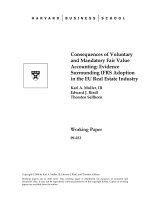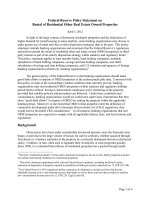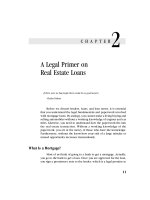HandBook Financing Secrets of a Millionaire Real Estate Investor_4 doc
Bạn đang xem bản rút gọn của tài liệu. Xem và tải ngay bản đầy đủ của tài liệu tại đây (519.07 KB, 21 trang )
74
FINANCING SECRETS OF A MILLIONAIRE REAL ESTATE INVESTOR
Some loans are called “no ratio” loans, in that you don’t have to
justify your total debt
(
mortgages plus other continuing obligations,
such as car loans and student loans
)
compared to your income.
Few, if any loans are true “no documentation” loans. Most of these
offered programs are bait and switch tactics: The lender says they
don’t need documentation, but when the loan is being processed, the
lender will ask for more and more documentation. Often, the lender
will see some red flags that trigger the additional inquiry.
The best defense to these tactics is a good offense; speak to your
lender or mortgage broker up front. Identify documentation issues up
front, educate the lender about your finances, and be truthful. The
more a lender suspects you are hiding something, the more documen-
tation the lender will ask for.
Here is a real-world example: Carteret Mortgage,
<
www.nva-
mortgage.com
>
, lists the following general guidelines for one of its
no-ratio mortgage loans:
•
Minimum middle credit score must be 640.
•
Five credit accounts are required; three may be from alterna-
tive sources—utility, auto insurance, etc.
•
Bankruptcy and foreclosures must be discharged for three
years with reestablished credit.
•
Two years’ employment with same employer.
•
Two months’ PITI reserves are required with an LTV less than
80 percent. Six months’ reserves are required otherwise.
•
10 percent minimum down payment is required from your
own funds. No gifts.
You should ask for this kind of information up front from your
mortgage broker or lender. The more information you know about
what a lender needs, the more information you can provide.
5 / Creative Financing through Institutional Lenders
75
Develop a Loan Package
You should present a loan package of your own to any new lender.
This package should include the following:
•
Your completed FNMA Form 1003 loan application
(
See Ap-
pendix C.
)
•
A recent copy of your credit report, with written explanations
of negative information
•
A copy of the purchase contract for the subject property
•
A copy of the down payment check and documented proof of
where it came from
•
Copies of recent tax returns, pay stubs, and W-2s
(
if applica-
ble
)
•
Recent appraisal of the property if you have one, or a market
analysis prepared by a real estate agent
•
Copies of existing leases or information of rental value of sim-
ilar properties
Watch What You Say on NI V Loans
Just because you don’t have to provide documen-
tation of your income to the lender, it doesn’t
mean you have a license to lie. Most lenders will
make you sign an authorization to release federal
income tax returns. They may not check now, but
if your loan goes into default, they may obtain cop-
ies of your tax returns. If the income you report on
your loan application is way out of sync with your
tax returns, you may be answering to loan fraud
charges.
76
FINANCING SECRETS OF A MILLIONAIRE REAL ESTATE INVESTOR
•
Copies of recent bank statements, retirement plan accounts,
and brokerage accounts
•
Any other relevant financial information concerning assets or
liabilities.
•
References from other bankers, lenders, or prominent mem-
bers of your community, such as a judge, politician, or bank
president
The more information you provide up front, the less surprises
the lender runs into, and hence the less likely it will be suspicious and
ask for more documentation.
Subordination and Substitution of Collateral
Subordination
is asking someone who holds a mortgage
(
or
deed of trust
)
on your property to agree to make his or her lien
sub-
ordinate,
or second in line, to another lien. For example, suppose you
own a property worth $100,000 that has a first mortgage to ABC Sav-
ings Bank for $65,000. If you want to borrow $30,000 from First
National Bank secured by a second mortgage, you would have to pay
a much higher interest rate because First National’s mortgage would
be subordinate, or second, to the lien in favor of ABC Savings Bank.
See Figure 5.2. A second lien position is riskier than a first lien posi-
tion, so the interest rate is generally higher to compensate the lender
for its increased risk. If you could convince ABC Savings Bank to move
its lien to second position, First National would now be a first mort-
gage holder and thus give you a better interest rate.
Keep in mind that you can use subordination to draw cash on
properties you already own. If you* purchased a property with seller
financing, simply ask the former owner to subordinate his or her mort-
gage to a new first. This may require you to give the seller some incen-
tive, such as additional cash or paydown of the principal. Either way,
subordination is an excellent way to finance a purchase or draw
money out of existing properties.
5 / Creative Financing through Institutional Lenders
77
Substitution of collateral
is a method of moving a lien from one
property, or collateral, to another. The substituted property does not
necessarily have to be real estate. You can use a car or boat title as the
substitute collateral. Better yet, get the mortgage holder to release the
mortgage with no substitute collateral! To get someone to take a note
without collateral, you need to offer a substantial cash down payment.
Think about this: If the note you give the seller is not secured by the
property, you can refinance or sell the real estate without paying off
the note.
Case Study: Subordination and Substitution
A property owner
(
we’ll call her Mrs. Seller
)
called me to discuss
selling her house. After some negotiations, we agreed to purchase the
property for $63,000 as follows:
•
$35,000 cash at closing of title
•
Promissory note and second mortgage
(
subordinate to a new
first
)
for $28,000, payable in installments of $350 per month,
no interest
FIGURE 5.2
Subordination
Free and
5% e
q
uit
y
65% LTV 1st Mort
g
a
g
e
30% LTV 2nd Mort
g
a
g
e
78
FINANCING SECRETS OF A MILLIONAIRE REAL ESTATE INVESTOR
She owned the house free and clear, so why would she do such a
thing? The answer is, to have her needs met. After some discussion,
she told me that she was sick of the upkeep of the property and
wanted a brand-new doublewide mobile home. The $35,000 cash was
for the new home, and the $350 per month would pay her mobile
home lot rent
(
just so you know that I didn’t “steal” the property from
some little old lady!
)
.
I went to a hard-money lender
(
discussed in Chapter 6
)
and bor-
rowed $37,500 at 12 percent interest
(
only $35,000 went to the seller;
the extra cash was for the points on the loan
)
. I closed escrow, placing
a new first mortgage in favor of the hard-money lender, and a second
mortgage
(
subordinate to the first
)
in favor of the seller for $28,000.
My total monthly payments were $725 per month, and I rented the
property to a nice family for $800 per month.
A few years later, I wanted to sell the property, so I called Mrs.
Seller and asked if she would be willing to take a discount on the
amount we still owed her, which was approximately $20,000
(
remem-
ber the original amount was $28,000
)
. She said that she liked the
monthly payments and didn’t want me to pay her off! With that, she
agreed to accept $10,000, release the mortgage from the property, and
allow us to continue making payments on the $10,000 balance of the
unsecured promissor y note. Not only did we profit from the sale of the
property, we also walked away from closing with an extra $10,000
cash in our pockets! The extra cash was due to the fact that we only
paid her $10,000 towards the balance of the $20,000 debt still remain-
ing. We continued to make monthly payments on the note, but be-
cause the security
(
mortgage
)
was released from the property, we
received the cash from the proceeds of the sale.
As you can see, subordination and substitution of collateral are
two powerful tools to make you more money in real estate.
5 / Creative Financing through Institutional Lenders
79
Using Additional Collateral
If the lender you are dealing with feels uncomfortable with the
collateral or your LTV requirements, offer additional security for the
loan. There are several ways to securitize a loan, other than with a lien
on the subject property.
Blanket Mortgage
A blanket mortgage is a lien that covers multiple properties. De-
velopers often use a blanket mortgage that covers several lots. When
each lot is developed and sold, the lien is released from that lot. A blan-
ket mortgage
(
or deed of trust
)
is just like a regular lien, except that it
names several properties as collateral. When recorded in county
records, the lien is now placed on each property named in the security
instrument. See Figure 5.3.
Zero-Interest Financing: The Exception
to the “Cash Flow Is King” Rule
In Mrs. Seller’s case, the payments on the high-
interest-rate first mortgage plus the owner-carry
second mortgage were only slightly less than the
market rent for the property. However, because
the payments on the owner-carry second were for
zero interest, the equity pay-down far exceeded
the value of the cash flow. Zero-interest financing
is one of the rare instances where monthly cash
flow is not the investor’s first concern.
80
FINANCING SECRETS OF A MILLIONAIRE REAL ESTATE INVESTOR
If you have other property with equity, even raw land, you can
offer this property as additional security for the loan. Be cautious,
however, with offering your personal residence as security; failure to
make payments can make you homeless!
Using Bonds as Additional Collateral
A bond, like a note, is a debt instrument. In return for the loan,
the investor is paid in full at a future date. Bonds generally pay interest
at fixed periods, unless they are zero-coupon bonds. The cash value
of a bond at any given time is based on the maturity date and its
present value, which in turn is based on whether investors are spec-
ulating interest rates will rise or fall in the future. As interest rates fall,
bond prices rise, and vice-versa. And, logically, the later the maturity
date, the less the present value of the bond.
Municipal and government bonds are virtually the same as cash;
they can be traded, sold, and hypothecated
(
used as collateral
)
. U.S.
Treasury bonds are safe, secure investments from a risk standpoint.
FIGURE 5.3
Blanket Mortgage
Lender
Investor
Single
Promissor
y
Note
Blanket
Mortgage on
all Properties
5 / Creative Financing through Institutional Lenders
81
From an investment standpoint, they are a fair to good bet, depending
on interest rates and market inflation.
Most laypeople think of bonds as being a secure investment. Of
course, institutional lenders are generally too savvy to accept the face
value of a bond as collateral. However, when dealing with a private
motivated seller, an owner-carry offer that is cross-collateralized with
U.S. Treasury bonds sounds appealing. When making an offer to a
seller with owner financing, offer the face value of the bond as collat-
eral. Although the present value may be less, the very idea of a bond
as additional collateral sounds safe. Furthermore, bonds can be used
in lieu of a down payment.
Example:
Sonny Seller owns a house free and clear and is
asking $100,000 for his house. Brian Buyer offers Sonny
$110,000 as follows: $30,000 in U.S. Treasury bonds and an
$80,000 note secured by a mortgage on the property. The
$30,000 in bonds, if they matured in 30 years, can be bought
for a fraction of their face value, depending on the market
interest rates. In the seller’s mind, he’s receiving more than
the asking price, but the buyer is paying much less than the
asking price
(
sometimes sellers are stuck on asking price
just because they are ashamed to tell their neighbors they
took less!
)
.
For an excellent reference on using bonds as collateral for real
estate financing, I recommend
Formulas for Wealth
by Richard Pow-
elson, Ph.D.
(
Skyward Publishing, 2001
)
. For more information on
bonds, try
<
www.savingsbonds.gov
>
.
☛
82
FINANCING SECRETS OF A MILLIONAIRE REAL ESTATE INVESTOR
Key Points
•
Avoid loan costs on flips—use the double closing.
•
Use the middleman technique to overcome lender down pay-
ment requirements.
•
Don’t let lack of income hold you back—use NIV loans.
•
Think beyond the property for collateral: substitute, subordi-
nate, and cross-collateralize.
83
CHAPTER
6
Hard Money and
Private Money
A loan shark is simply a thief without a Wall Street office.
—Lyndon H. LaRouche, Jr.
An often overlooked and very valuable source of funding is pri-
vate money. Small companies and individual investors called “hard-
money lenders” are an excellent resource for quick cash. Private
lenders are often known as hard-money lenders because they charge
very high interest rates. I have personally borrowed at 18 percent
with 8 points as an origination fee! These rates may sound outra-
geous at first blush, but it is the availability of the money not the cost
that matters.
Emergency Money
I recently won with the high bid on a condominium auctioned by
the Department of Veterans Affairs
(
VA
)
. I made the bid in the name of
a corporation rather than my individual name. I was assured by my
mortgage broker that the lender that had my loan application would
84
FINANCING SECRETS OF A MILLIONAIRE REAL ESTATE INVESTOR
permit me to finance the purchase in a corporation. At the 11th hour,
the lender changed its mind, requiring me to close in my individual
name. I asked the VA for permission to amend the purchase contract
to name me, rather than my corporation. The VA refused, and I now
had less than five days to close or lose the deal. Because my winning
purchase bid was an excellent price, I opted for using hard money to
purchase the property. I paid 14 percent interest for a few months,
then refinanced the property at a good interest rate. All in all, the high
cost of the hard-money loan was worth it and saved me in a pinch.
Hard-money lending criteria are based on the collateral
(
the prop-
erty
)
rather than the financial strength of the borrower. For this rea-
son, hard-money lenders are often referred to as “equity” lenders. A
hard-money lender looks at a loan, thinking, “Would I want to own
this property for the amount of money I lend this person?” Hard-
money lenders generally go no higher than a 75 percent loan-to-value.
The goods news, however, is that many hard-money lenders will base
their loan on appraised value, not purchase price. So, if you negotiate
a very good purchase price, you may end up with an 85 percent loan-
to-purchase ratio.
Hard-money lenders can be expensive but also easy to deal with
if you are in a hurry for the money. In many cases, the availability of
the money is more important than the cost of borrowing it.
Where to Find Hard-Money Lenders
Hard-money lenders are fairly easy to find, once you know where
to look. The first place is your local newspaper, under “money to loan.”
The ads will usually look something like this:
Stop Foreclosure! Real Estate Loans.
Fast and Easy. No Credit Required.
48-Hour Funding. Call Fred 555-1134.
6 / Hard Money and Private Money
85
Many hard-money lenders advertise on the Internet. Try a Yahoo!
search of the Internet for hard-money lender Web sites. Not all hard-
money lenders call themselves that; some use the title “equity based
lender.” It is best to find one that is located within your state. A refer-
ral from another local real estate investor is helpful, too. For a referral
to a local real estate investors club in your city, try the National Real
Estate Investors Association at
<
www.nationalreia.com
>
.
Borrowing from Friends and Relatives
Friends and relatives seem like obvious choices for borrowing
money, but they may be as skeptical as an institutional lender. They
may try to boss you around and nag you about when you expect to
repay the money you borrowed. They may also want to be part of the
daily decision-making process, which would interfere with your bus-
iness. And, of course, they may be emotional about their money,
whereas institutional lenders don’t take money matters personally.
Borrower Beware!
Soliciting money from private investors can
be a dangerous practice. Federal securities laws may apply to public
solicitations of money as a “public offering.” In addition, state securi-
ties regulations
(
known as “Blue Sky Laws”
)
may also apply. Simply
running a blind ad in the paper stating, “Private Money Wanted for
Real Estate Purchase—12% Return” may result in a call from your state
Attorney General’s Office. If you are approaching a friend, relative, or
individual investor to borrow money secured by a specific property,
then you are probably OK; borrowing money for a “pool” of funds
becomes trickier. Also, when you deal with strangers, multiple par-
ties, or the public at large, you should seek the advice of a local attor-
ney knowledgeable about state and federal securities regulations.
86
FINANCING SECRETS OF A MILLIONAIRE REAL ESTATE INVESTOR
Using Lines of Credit
A home equity line of credit
(
HELOC
)
can be an excellent financ-
ing tool, if it is used properly. A HELOC is basically like a credit card
secured by a mortgage or deed of trust on your property. In most
cases, it will be a second lien. You only pay interest on the amounts
you borrow on the HELOC. You can access the HELOC by writing
checks provided by the lender.
HELOCs are being advertised on television as a way to consolidate
debt, but they can be used much more effectively by investors. When
you need cash in a hurry for a short period of time, a HELOC can be
very useful. For example, if a seller tells you to give him “$75,000 cash
on Friday and I’ll sell you my house for a song,” you need to act in a
hurry. Another example of cash in a hurry is a foreclosure auction,
which, in many states, requires payment at the end of the day of the
auction. When you need cash in a hurry, there’s no time to go to the
bank.
While the HELOC may be a high-interest-rate loan, it is a tempo-
rary financing source that can be repaid when you refinance the prop-
erty.
Do not use your HELOC as a down payment or any other long-
term financing source—it will genera lly get you into financial trou-
ble.
Furthermore, an institutional lender may not lend you the balance
if you borrowed the funds for the down payment.
Warning:
Failure to pay your HELOC means you lose your home!
Use your HELOC wisely and only if it means losing a steal of a deal if
you don’t!
Credit Cards
You may already have more available credit than you realize.
Credit cards and other existing revolving debt accounts can be quite
useful in real estate investing. Most major credit cards allow you to
take cash advances or write checks to borrow on the account. The
transaction fees and interest rates are fairly high, but you can access
this money on 24 hours’ notice. Also, because credit card loans are
6 / Hard Money and Private Money
87
unsecured, there are no other loan costs normally associated with a
real estate transaction, such as title insurance, appraisals, pest inspec-
tions, surveys, etc.
Often, you will be better off paying 18 percent interest or more
on a credit line for three to six months than paying 9 percent interest
on institutional loans that have up-front costs that would take you
years to recoup. Again, use credit cards carefully and only as a tempo-
rary solution if the deal calls for it.
Key Points
•
Hard money is an excellent short-term financing tool.
•
HELOCs and credit cards are excellent sources for fast cash.
Deducting HELOC Interest
There are limits on the deductions you can take on
your personal tax return for interest paid on your
HELOC. Generally speaking, you can only deduct
that portion of interest on debt that does not ex-
ceed the value of your home and is less than
$100,000. But, if you do your real estate invest-
ments as a corporate entity, you can always loan
the money to that entity and have the entity take
the deduction as a business interest expense. This
transaction must, of course, be reported on your
personal return and must be an “arms-length”
transaction
(
i.e., documented in writing and with-
in the realm of a normal business transaction
)
.
Consult with your tax advisor before proceeding
with this strategy.
CHAPTER
7
Partnerships and Equity Sharing
The guy with the experience approaches the guy with the money. When the deal is com-
plete, the guy with the experience has the money, and the guy who had the money has
experience.
—Anonymous
If you are low on cash or have cash and are low on time, a part-
nership or equity-sharing arrangement may be for you. Using part-
ners to finance real estate transactions is the classic form of using
other people’s money
(
OPM
)
. Experienced investors are always will-
ing to put up money to be a partner in a profitable real estate transac-
tion. As with many businesses, talent is more important than cash. If
you can find a good real estate deal, the money will often find its way
to you!
Partnership arrangements work in a variety of circumstances.
The most common scenario involves one party living in the property
while the other does not. Another scenario may involve all of the par-
ties living in the property. These arrangements are common among
family members. Parents often lend their children money for a down
payment on a house, with a promise of repayment at a later date. If
90
FINANCING SECRETS OF A MILLIONAIRE REAL ESTATE INVESTOR
the repayment of the debt is with interest and/or relates to the future
appreciation of the property, we have a basic equity-sharing arrange-
ment.
Another common financing arrangement between multiple par-
ties is a partnership wherein none of the parties live in the property.
This chapter will discuss the basic partnership investment. Larger
investments through limited partnerships and other corporate enti-
ties in a “pool” of money are known as “syndications.” These invest-
ments are generally classified as securities, so compliance with state
and federal regulations is complex. Thus, syndications are generally
not recommended for financing smaller projects because the legal
fees for compliance with securities laws will far exceed the benefit of
raising capital through multiple investors.
Basic Equity-Sharing Arrangement
The common equity-sharing arrangement involves one party liv-
ing in the property and the other putting up cash and/or financing.
Both the occupant and the nonoccupant enjoy tax benefits and share
the profit, as described later in this chapter. First-time homebuyers
make the best resident partners while family members, sellers, and
real estate investors fill the nonresident partner role.
Scenario #1: Buyer with Credit and No Cash
A lot of potential homebuyers have the income to qualify for a
mortgage loan, but only with a substantial down payment. With a
small down payment, the monthly loan payments may be too high. A
potential homebuyer could borrow the money for the down payment,
but nobody but a fool
(
or a parent
)
would lend $25,000 or more unse-
cured. Furthermore, loan regulations generally do not permit the use
of borrowed money as a down payment.
7/ Partnerships and Equity Sharing
91
An equity-sharing partner could put up the money in exchange
for an interest in the property. The resident partner would obtain the
loan, live in the property, make the monthly loan payments, and main-
tain the property. The nonresident partner who puts up the down-
payment money is free from management headaches and negative
cash flow. After a number of years
(
typically five to seven
)
, the prop-
erty is sold, the mortgage loan balance is paid in full, and the profits
are split between the parties. Obviously, the strategy works best in a
rising real estate market.
Scenario #2: Buyer with Cash and No Credit
The second equity-sharing scenario would be a buyer with cash
but an inability to qualify for institutional financing. The resident part-
ner would put up the down payment, the nonresident partner would
obtain the loan. After a number of years, the property is sold, the mort-
gage loan balance is paid in full, and the profits are split between the
parties.
Your Credit Is Worth More Than Cash
Just because you put up credit and no cash does not mean you
aren’t at risk. Cash is easy to come by, but good credit takes years to
build, and only months to ruin. As I write this book, an investor friend
of mine
(
we’ll call him Brian
)
recalls his first deal. Brian was a neo-
phyte investor who was approached by an experienced investor with
the following proposal: “You put up your credit to get the loan; I’ll put
up the cash for the down payment.” Brian bought the property with
the investor in this manner, but Brian did not manage the property.
Brian received a call from the lender a year later and was informed
that the mortgage loan had not been paid in several months. Brian was
unable to locate his partner who had apparently collected the rents
and skipped town.
The moral of this story: Use your credit wisely—cash can be re-
couped in a few months, but credit blemishes can take years to fix.
92
FINANCING SECRETS OF A MILLIONAIRE REAL ESTATE INVESTOR
Tax Code Compliance
Equity sharing arrangements are governed by Section 280A of
the Internal Revenue Code
(
IRC
)
. Labeled a Shared Equity Financing
Agreement
(
SEFA
)
, IRC Section 280A permits the nonresident partner
investment property tax benefits
(
namely depreciation
)
. In addition,
the resident partner can take advantage of the benefits of owning a
principal residence
(
namely, the mortgage interest deduction
)
.
The nonresident partner is essentially treated for tax purposes as
a landlord, taking depreciation for his or her ownership interest to the
extent he or she receives rent. So, for example, if fair market rent for
the property is $1,000 per month and the resident/nonresident equity
split is 60/40, then the resident must pay $400 in rent to the nonresi-
dent partner if the nonresident wants to take the depreciation deduc-
tion. In turn, the nonresident partner returns the rent to property
expenses for which the resident partner is responsible
(
in this way,
the cash contribution by the resident partner is not increased—it is just
shifted to conform with the tax code
)
. If the resident does not pay
rent, but rather makes all of the mortgage interest payments directly
to the lender, then the investor receives no tax benefits, leaving them
all to the resident. The agreement can be made in a number of ways,
depending on the needs of the parties and their needs for the tax de-
ductions.
The parties must have a co-ownership agreement that complies
with IRC Section 280A in order to reap the benefits of this mixed use
tax plan. If the relationship is deemed a “partnership” by the IRS, then
the rules of IRC Section 280A are not applicable. A highly recom-
mended book that covers the tax implication in detail is
The New
Home Buying Strategy
by Marilyn Sullivan, Esq.,
<
www.msullivan
.com
>
.
7/ Partnerships and Equity Sharing
93
Pitfalls
A joint ownership arrangement can be problematic if the resident
does not maintain the property or make the mortgage, insurance, or
property tax payments. Furthermore, if the property does not go up
in value, the nonresident party who put up the credit or cash may not
realize any profits. Like any real estate investment, the shared equity
arrangement should be approached with profit and not just financing
in mind. In other words, make sure you buy the property at a good
price and/or in the right neighborhood at the right time.
Alternatives to Equity Sharing
For the nonresident investor, there are several alternatives to the
equity-sharing arrangement. The first is the lease option, which is dis-
cussed in more detail in the Chapter 8. The second is a joint venture.
Depreciation Is Often an
Overrated Deduction
With breakeven or even slightly positive cash flow,
the deprecation deduction creates a “paper loss”
for the investor. The loss can be used to offset the
investor’s other income. Keep two things in mind.
First, the deduction is not always available to the
investor, depending on his other income. Second,
the depreciation taken on a rental property is
recaptured
(
realized as a gain
)
when the property
is sold. In short, don’t always assume that you need
the depreciation deduction—always review the
issues with a professional tax advisor before pro-
ceeding.
94
FINANCING SECRETS OF A MILLIONAIRE REAL ESTATE INVESTOR
Joint Ventures
A
joint venture
is a limited-purpose general partnership. A gen-
eral partnership is formed when two or more people engage in a bus-
iness with the intention of sharing profits and losses. A partnership
need not necessarily be in writing, although it is generally a good idea.
A joint venture is a general partnership that is limited in scope. Thus,
if two individuals agree to buy a particular property with the inten-
tion of making a profit, the two individuals are not necessarily in bus-
iness to buy properties; the scope of the partnership is limited to that
one venture.
Under the federal tax code, a joint venture participation in a
rental property does not necessarily create a partnership. So, while
two individuals may co-own a rental property, they do not necessarily
have to file a partnership return. However, if two or more individuals
engage in multiple rental property investments, this may trigger
reporting for federal tax purposes. For more information on partner-
ship tax reporting, read IRS Publication 541
(
get a free download at
<
www.irs.gov
>
)
.
Using Joint Venture Partnerships for Financing
Joint venture partnerships can be an excellent way to finance a
real estate transaction, and they can be handled in a variety of ways.
The most common is where one partner puts up cash and the other
puts up his or her interest in the deal and/or his services in managing
the property. The joint venture agreement will spell out how the
money is contributed and how it is disbursed. Title to the property is
generally held in the name of the joint venture, although title can be
taken in the name of one or both of the partners. Using a partner to
finance deals can be very effective on a deal-by-deal transaction.
Sometimes a joint venture partnership looks more like a general
partnership because it is not specific to any one particular property.
For example, an investor, or group of investors, may “pool” money









